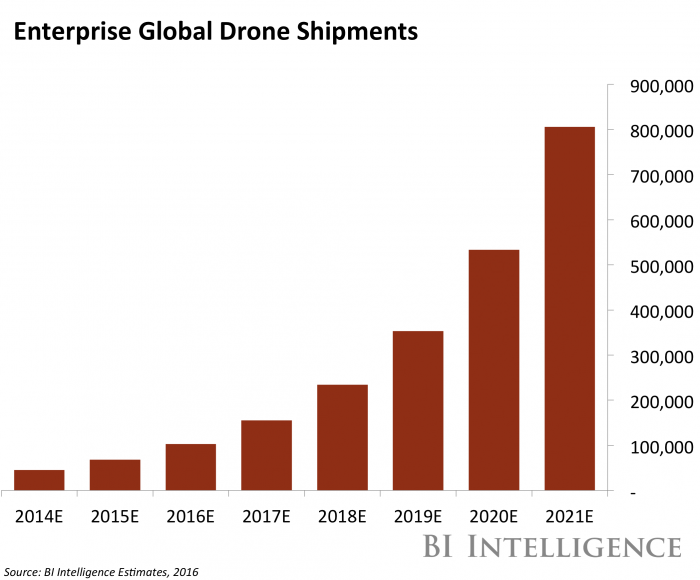FAA report shows pilots are seeing more drones

BI Intelligence
This story was delivered to BI Intelligence IoT Briefing subscribers. To learn more and subscribe, please click here.
One of the primary issues surrounding the proliferation of drones is their interference with other aircraft.
A new report from the Federal Aviation Administration (FAA) confirms that while more drones are being spotted by pilots of other aircraft, there have not yet been any collisions with planes or helicopters.
If this trend continues, it could present issues down the road as enterprise drone usage grows, especially once logistics providers try to launch drone delivery services.
To a degree, this is a natural phenomenon that’s the result of heightened enterprise drone usage. In a report last year, BI Intelligence analyzed the emerging enterprise drone space and identified several prominent use cases driving this adoption. The fact that more pilots are spotting drones in the skies is likely a result of this phenomenon, though it could also point to negligence on the part of enterprises and consumers who use the drones.
But while not currently an issue, a high-profile collision could cause the FAA to rethink its drone delivery policies. The agency is mandated by Congress to release regulations on commercial drone delivery services sometime next year. However, if the number of drones continues to grow and a significant crash were to occur, this could prompt the FAA to move to restrict drone usage ahead of the much-anticipated legalization of a commercial drone delivery service.
Drones turned the corner in 2015 to become a popular consumer device, while a framework for regulation that legitimizes drones in the US began to take shape. Technological and regulatory barriers still exist to further drone adoption.
Drone manufacturers and software providers are quickly developing technologies like geo-fencing and collision avoidance that will make flying drones safer. The accelerating pace of drone adoption is also pushing governments to create new regulations that balance safety and innovation.
Safer technology and better regulation will open up new applications for drones in the commercial sector, including drone delivery programs like Amazon’s Prime Air and Google’s Project Wing initiatives.
BI Intelligence, Business Insider's premium research service, has compiled a detailed drones report that forecasts sales revenues for consumer, enterprise, and military drones. It also projects the growth of drone shipments for consumers and enterprises.
The report details several of world’s major drone suppliers and examines trends in drone adoption among several leading industries. Finally, it examines the regulatory landscape in several markets and explains how technologies like obstacle avoidance and drone-to-drone communications will impact drone adoption.
Here are some of the key takeaways from the report:
We project revenues from drones sales to top $12 billion in 2021, up from just over $8 billion last year.
Shipments of consumer drones will more than quadruple over the next five years, fueled by increasing price competition and new technologies that make flying drones easier for beginners.
Growth in the enterprise sector will outpace the consumer sector in both shipments and revenues as regulations open up new use cases in the US and EU, the two biggest potential markets for enterprise drones.
Technologies like geo-fencing and collision avoidance will make flying drones safer and make regulators feel more comfortable with larger numbers of drones taking to the skies.
Right now FAA regulations have limited commercial drones to a select few industries and applications like aerial surveying in the agriculture, mining, and oil and gas sectors.
The military sector will continue to lead all other sectors in drone spending during our forecast period thanks to the high cost of military drones and the growing number of countries seeking to acquire them.
In full, the report:
Compares drone adoption across the consumer, enterprise, and government sectors.
Breaks down drone regulations across several key markets and explains how they’ve impacted adoption.
Discusses popular use cases for drones in the enterprise sector, as well as nascent use case that are on the rise.
Analyzes how different drone manufacturers are trying to differentiate their offerings with better hardware and software components.
Explains how drone manufacturers are quickly enabling autonomous flight in their products that will be a major boon for drone adoption.
To get your copy of this invaluable guide, choose one of these options:
Subscribe to an ALL-ACCESS Membership with BI Intelligence and gain immediate access to this report AND over 100 other expertly researched deep-dive reports, subscriptions to all of our daily newsletters, and much more. >> START A MEMBERSHIP
Purchase the report and download it immediately from our research store. >> BUY THE REPORT
The choice is yours. But however you decide to acquire this report, you’ve given yourself a powerful advantage in your understanding of the world of drones.
See Also:

 Yahoo News
Yahoo News 

